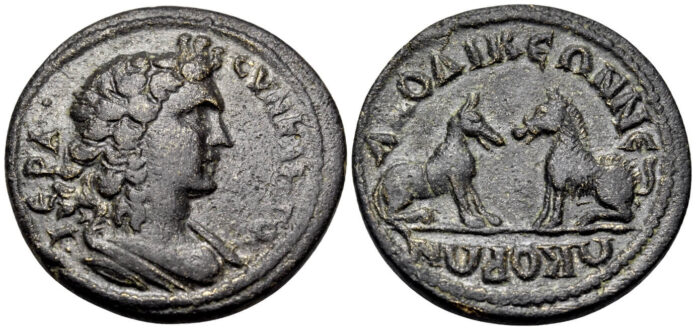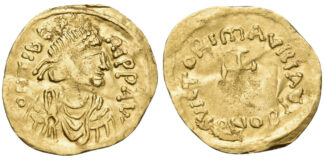Obolos 15 Now Online
At long last, we have finally finished Obolos 15, which is now online, with all sorts of coins for you to enjoy (it closes on 24 May beginning at 15:00 CET). Yes, it has taken a surprisingly long time to get it ready, but this can be explained by the essential goodness and, yes, kindness, of our Director who not only wants to please all our collectors by providing them with interesting and exciting coins, he also wants to help out those bringing us coins to sell for them. What happens is that every time we think the sale is complete, and we are just about to close it, someone appears in the office with yet more coins for auction, which he urgently wants to sell. And so, the catalogue has to be changed: that’s why we thought we were going to have a sale with around 800 lots and now have 1,154!
In addition, this huge Covid-19 crisis we are all going through means that e-sales are the only viable way to present coins to the numismatic world: room sales are out. So we really do hope that all of you, who basically will not be able to see coins in person, will have an enjoyable time looking through the coins we have in this auction. They range from Celtic, Greek and Roman through Byzantine, Crusaders, Islamic, Medieval and early Modern European; and there are multiple lots too. There really is something for everyone. So here are some pieces that have caught my eye…
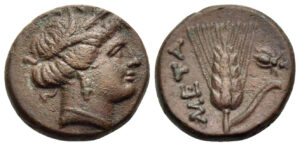
Greek bronze coins often seem only to be found relatively worn, with really nice ones in about EF condition or better being truly difficult to discover. In fact, it is often much easier to find nice Greek silver pieces than Greek bronzes. There is a good reason for this: silver and gold were struck to specific weight standards so when they became heavily worn their value went down in relation to their face value, with the result that they were then melted. Bronze coins, however, virtually never had an intrinsic metal value equal to their accepted tariffed or face value, with the result that wear had little effect on their acceptability. Thus, as long as their size allowed them to fit in with the denominational system then in use, and there was no other reason to preclude them from circulating – they might have become unacceptable for political reasons – they could continue circulating for several hundred years after they were struck. In Athens, for example, in contexts dating to the Herulian destruction of 267 the excavators found virtually worn-flat post-Sullan Athen bronze issues (c. 70s – 20s BC) along with Roman Provincial Athenian issues of similar size, including often very worn ones from the Hadrianic period and quite fresh pieces that had been struck during the visit of the emperor Gallienus in 264. They must have all had roughly the same value.
Clearly, really nice Greek bronzes are worth snapping up when you can find them. So here’s one:
This is lot 40, a Chalkous struck by Metapontum c. 300-250 BC (starting price [SP], 50 CHF), which has a barley-wreathed head of Demeter on the obverse and the standard barley ear on the reverse. She is a quite youthful looking goddess, with a pendant earring and a torc-like necklace, but what is particularly endearing about this piece is the magistrate’s symbol on the reverse, a very realistically engraved fly! Boldly engraved, of fine style and with a lovely brown-tan patina, what’s not to like?
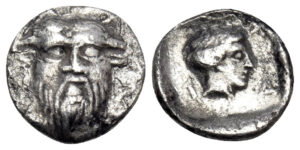
This coin can only be described as excitingly numismatic in every way! And not only because it is unpublished and unknown! It is lot 197 (SP 250 CHF), a diobol from Stratos in Akarnania dating to c. 425-380 BC. On the obverse we have a fully facing head of the horned river god, Acheloos (vaguely reminiscent of our Thasian satyr), and on the reverse we have a rather severe and serene head of the nymph Kallirhoe, Acheloos’s daughter and the mother of Akarnan, who was the mythological founder of Akarnania! We can be sure of her identification since the first three letters of her name, ΚΑΛ, can be read on the coin. Despite the corroded surfaces, the truly fine style of this coin shines through: Acheloos has an air of majestic power well showing the die engraver’s mastery of his craft. Yet another extraordinary fact about this coin is that it was not in the BCD Collection, thus proving its great rarity.
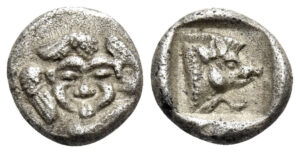
Here we have an iconographically surprising later 5th century BC obol from an uncertain mint in Caria (lot 379, SP 75 CHF). The forepart of a boar on the reverse is something we have often seen before elsewhere – in Phocis, at Kyzikos, in Lykia, etc. – but the obverse type, a facing gorgon’s head encircled by four wings, is most unexpected. While multi-winged creatures are familiar from Mesopotamian mythology, the way the head is depicted is highly reminiscent of the way two groups of angels, the Cherubim and the Seraphim, appear in Judaeo-Christian iconography! These beings are often shown as a facing head with wings attached, in the case of the Seraphim usually six, but with only four, as here, for the Cherubim. It would be intriguing to explore the links between gorgons and angels, but that would be a truly serious project, which can’t be done here.
Now for something watery…
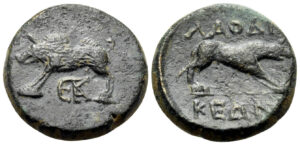
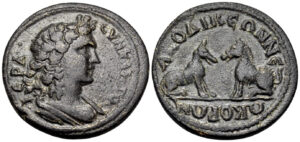
The top coin, which shows a wild boar standing to left on the obverse and a wolf standing to right on reverse, is lot 422 (SP 50 CHF) from Laodikeia in Phrygia and is late Hellenistic in date. The one below shows the same two animals, but seated, confronting each-other, with the wolf on the left and the boar on the right (lot 639, SP 200 CHF); it is described as being from Laodicea ad Lycum in Phyrgia and dated to the late 240s AD. You may wonder why the city names are given in Greek and in Latin: that is actually a clever way of showing that one was struck prior to Augustus and one later! What is really intriguing are the animals: they actually represent two of the three rivers/streams that water the city. The wolf represents the most important of the three, the river Lykos (= Wolf River), while the boar symbolises the river Kapros (= Boar River), which, with the river Asopos (named after a river god who is better known from his appearances in Boeotia), joined the Lykos upstream from where the Lykos joined the Maeander. In the description of lot 422 these two animals were described as being river gods: they are, rather, personifications, which rightly describe the rivers’ power in spring, when they were at flood and raged down into the Maeander.
This is enough for today! Remember, you can find the entire sale on the Nomos web site, on Sixbid, on Biddr and on NumisBids; do look at all the lots because there are a lot of interesting and attractive lots!
For any questions about the sale contact Nomos AG via e-mail.



